When a City Became a Spiral

Rea,
You know how we live in North University in Austin? Have you ever wondered why it’s called that? It got its name simply because it’s north of the University of Texas. That’s how most American neighborhoods get their names - based on a landmark, a street, or some local history.
But Paris does things completely differently. Instead of named neighborhoods, Paris is divided into numbered districts called “arrondissements.” And here’s the fascinating part - they’re arranged in a spiral pattern, almost like that golden spiral project you did earlier this year.
The spiral starts right in the center of Paris with the 1st arrondissement, where you’ll find the Louvre Museum. Then it winds outward in a clockwise direction, like a snail shell, all the way to the 20th arrondissement at the outer edge. When we stayed on Rue Mérimée last summer, we were in the 16th arrondissement - you can tell from the postal code 75116, where those last two digits reveal your location in the spiral.
This wasn’t a random choice. After years of medieval chaos, French revolutionary leaders wanted to bring mathematical order to their capital. They believed a logical system would make the city easier to govern and navigate. It’s like they were applying the mathematical patterns found in nature to organize human life.
Each arrondissement has developed its own personality over time. The 16th, where we stayed, is known for elegant apartments and embassies. The 5th is the historic Latin Quarter with universities. The 18th contains artistic Montmartre with its famous white-domed church on the hill.
This spiral system stands in stark contrast to how American cities organize themselves. In New York, you have neighborhoods like SoHo (South of Houston Street) and Tribeca (Triangle Below Canal Street). In Austin, besides North University, we have areas like Clarksville and Hyde Park, named for people or old estates.
The Paris system shows how a mathematical approach to organization can create something both practical and beautiful. Once you understand the spiral, you can quickly figure out where any address is located in relation to the center of the city. It’s like having a built-in map in every address.
The next time you look at a map of a city, see if you can spot the pattern in how it’s organized. That pattern might tell you something about what the people who designed it thought was important.
Love, Abba
P.S. If you were designing your own city from scratch, how would you organize it? Would you use a grid, a spiral, or something completely different?

